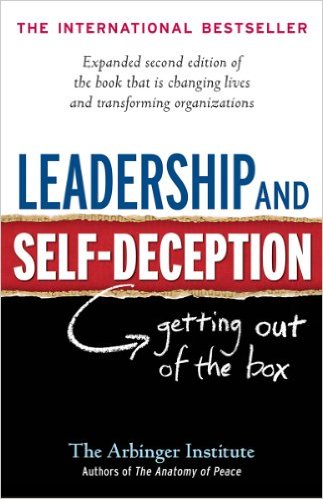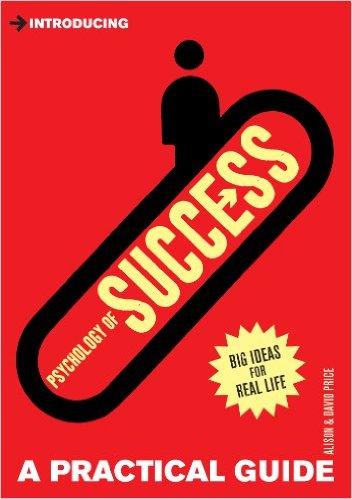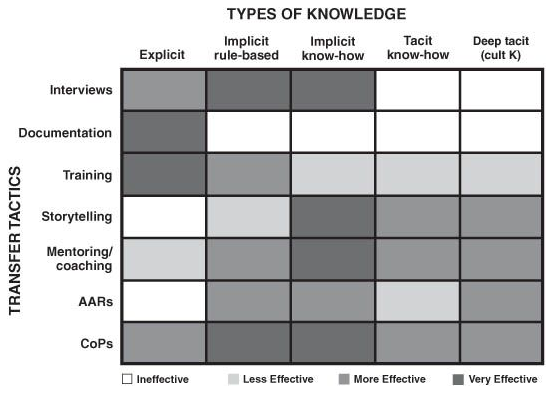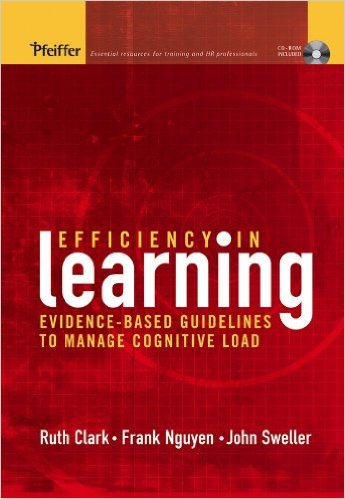In San Francisco at SPTechCon, I slipped into a session Bill English was doing and he mentioned a book, Diffusion of Innovations. The context was that Bill was talking about where the groups innovators, early adopters, early majority, late majority, and laggards came from. Since in my work I spend a non-trivial amount of time getting folks to get value out of SharePoint and that means driving adoption (and engagement), I was curious as to the research roots of how innovations diffuse throughout a system (an organization.)
The book is at its heart an academic book and that means not only it’s more expensive but it’s also a bit drier than your typical business reading. However, what it lacks in engagement it makes up for in depth. In short, if you’re looking to be engaged and entertained this isn’t the book for you – but if you’re really interested in getting to the heart of diffusion, you may want to pick it up. With that disclaimer out of the way, what insight does the book offer? It offers quite a bit – more than makes sense for a blog post by a wide margin, but here are some highlights.
What is Innovation?
Before we can talk about how innovations diffuse through a system it’s important to define innovation. The book defines it like this:
An innovation is an idea, practice, or object that is perceived as new by an individual or other unit of adoption. It matters little, so far as human behavior is concerned, whether or not an idea is “objectively” new as measured by the lapse of time since its first use or discovery. The perceived newness of the idea for the individual determines his or her reaction to it. If an idea seems new to the individual, it is an innovation.
Knowledge, Attitudes, and Practices (KAP)
One of the traditional models of diffusion has been a model of Knowledge, Attitudes, and Practices – abbreviated as KAP. The model has been used for many years in terms of the ability to drive innovation – often religion – into third world countries. Because of the volume of its use and its simplicity, we’ll start by explaining the diffusion of innovations through this lens.
One of the interesting things that seems to happen when you deploy to SharePoint to an organization is that everyone that learns about SharePoint doesn’t immediately start to adopt SharePoint. This seems obvious but also curious. If all that’s missing is for someone to realize that their life would be better if they stopped chasing emails and attachments and simply filed things into SharePoint – then why aren’t they doing that? I’ve already mentioned the impact of habits in my book reviews of Switch and The Happiness Hypothesis, but there’s more to it than that.
Knowledge is most easily achieved by mass media. You buy a commercial, get promoted on a popular TV show, or some other way communicate the message to a large number of folks. Guerilla Marketing offered up Thomas Smith’s writing from 1885 which says that a typical buyer need 20 times of seeing something before he’ll buy (and gets pretty frustrated in the middle because he’s seeing it so much.) While Diffusion of Innovation and Frank Bass’ Prediction (Diffusion) Model might argue that there are better ways to communicate – the concept that it takes many exposures to the message in order to just create knowledge. If we go back to Bloom’s Taxonomy of Educational Objectives we’ll find that the lowest rung of educational objectives is remembering. Remembering is recognition first (I’ve seen this before) and recall (I can remember it on command). Just above that in the taxonomy is Understanding then Application and so on. Understanding and Application are about integrating our understanding of the knowledge so that it’s connected to and used by other parts of our thinking.
We can drive repetition all day long. We can so ingrain the knowledge that it can be repeated mindlessly, however, this won’t necessarily change how we feel about something. Consider for instance the very popular advertising campaign of Wendys from several years back. The key tagline was “Where’s the beef?” You can still see this tagline occasionally on t-shirts and it will still randomly come up in conversation. Although the marketing campaign was a success for Wendys, they drove many more people to know about their claim that they had more beef than they actually changed attitudes for – or got to come to their restaurants. In short, gaining knowledge isn’t enough. It’s just the first step. The next step, changing attitudes isn’t as easy as repetition.
Attitudes – or how someone feels about the innovation is more difficult. Where knowledge can be produced through mass communication, changing attitudes is necessarily a social proposition. A person’s attitudes are swayed by those they trust. Most folks intuitively recognize that they cannot be an expert on every topic. They don’t have time to learn all there is to know about something. The Paradox of Choice keenly pointed out that the more that we are confronted with choices (say on what things to learn) the less able we are to make good decisions. Instead we use proxies for our knowledge. That is we trust others to help us understand the implications without knowing the details. Attitudes are an abstraction for the detailed knowledge of the innovation and the systems or norms that it interacts with. They are in effect a schema for how things are – ala Efficiency in Learning. Attitudes are very difficult to influence with mass media. There are numerous marketing tricks like showing you happy, seemingly successful people using the product – however, they’re generally speaking not very effective at pushing you to the real goal – changing your practices.
Practices is really using the innovation. That’s the goal of the whole thing – to use the practices to take advantage of the innovation. If we’re working on family planning methods then our goal may be to encourage the use of contraceptives (or abstinence). In program after program, in study after study, the folks that believe the innovation will be helpful far outstrips the number of people who actually do it. We all know that eating healthy and exercise is good for us, few of us actually do both of these consistently.
One analogy that may be helpful is used all the time in sales circles. That is the concept of a sales funnel. That is at the top of the funnel there are incoming (or outgoing) leads. The bottom of the funnel ends with actual sales. The way that people break the funnel up in between differs a bit from situation to situation but in general leads are converted to prospects. Prospects are further refined into opportunities and the opportunities either result in a sale – or not. The inherent idea in the funnel is that each step of the process loses some of the folks. You start with more leads than you end up with in Sales. When doing email marketing a good “rule of thumb” is that you’ll get about 10% of your messages opened and then you’ll get action out of about 10% of the folks that opened the message – A net result of 1% of the people that you send an email to will take action. These aren’t bad guidelines, they set your expectations pretty well.
In innovation terms, many will know about the innovation, fewer will believe that the innovation is valuable, fewer still will do something about it. The diffusion of the innovation relies upon multiple overlapping interactions with the intended system – until the 1% taking a response starts to drive others in the system to change their behavior – then that group encourages more change and so on.
Five Stages of the Innovation Decision Process
At the heart of diffusion of an innovation is having a person or organization decide to adopt the innovation. The book outlines five stages of the innovation decision process. This is an expansion of sorts of the KAP model above as it applies checkpoints to the process where the KAP model is a rather fluid model where one flows into the next with less of a clear distinction. Here are the five stages:
- Knowledge – The person or organization learns about the innovation.
- Persuasion – The person or organization is persuaded to use the innovation.
- Decision – The person or organization makes a decision (or commitment) to implement the innovation.
- Implementation – The person or organization actually implements the innovation (this is where they start to practice the innovation).
- Confirmation – During the confirmation period the person or organization is susceptible to rejection of the innovation if they don’t see results or even if there are substantial other forces saying that the innovation isn’t good for them.
The key difference between the stages and the KAP model are that this model is, as stated above the more milestone based view, but also it redefines the boundaries. In the KAP model the Attitude portion includes both the persuasion of the party as well as the decision – or part of it. The other half of the decision is covered in practice. Here, persuasion, decision, and implementation are three separate stages. In many implementations I see that both a decision is never made formally and explicitly and as a result the implementation gets sideways. By calling out the decision as a stage it’s given importance to reach a decision to adopt. Said differently, we get a commitment to the innovation.
Innovation Rejection
The final stage of the five stages – confirmation – is an addition when compared to the KAP model. It’s recognizes that it’s possible for a person or organization who has previously accepted an innovation can reject it. We’re familiar with the idea that folks can reject an innovation when it’s presented. In fact, everyone initially rejects an innovation because they don’t have enough knowledge, they don’t have the right attitude, or they’re not ready.
The difference with the confirmation stage is that it’s talking about rejection – after someone has adopted. This is the period of time immediately after the decision (and optionally the implementation) when the person or organization is open to reversing their decision. For some this is very short and others this can last for years. The idea is that even though they committed to implementing the innovation – they didn’t commit to the long term use of the innovation. We’ve all seen this in large organizations where new approaches are implemented and then quickly pulled when it’s discovered that they don’t fit the organization. There are two key things that can swing folks back over to rejecting an innovation. First is negative experience – that is they don’t see the results they want or they see a serious unintended consequence. They can also get this via proxy through others and make the decision to reject because of a trusted person who reports they had a bad experience.
Once the confirmation phase is over, an innovation will still eventually get rejected. Generally this is either because it was replaced with a better innovation or because they no longer see the benefit of the innovation – whether it’s present or not.
The Law of Unintended Consequences
One of the reasons folks discontinue an innovation is because it leads to unintended consequences. The book is careful to point out that unintended and unwanted consequences are going to happen. While it’s possible to predict the function of an innovation – what it does – it’s nearly impossible to predict what meaning it will have for an organization. The book talks about steel axes given to an aboriginal tribe, the war on mosquitoes with DDT, but I think that for me a more poignant example is the impacts we’ve had with our Engineering feats. Take for instance, the impact of damns on fish. We were building damns for great reasons, water conservation, erosion control, hydroelectric power generation, etc., however, we weren’t able to see the impact this would have on fish. The good news is we discovered that we could create fish ladders to work around this environmental impact. Similarly and more tragically, science and engineering improved the strength and design of bridges until the point where a variable that was ignored – aerodynamic effect – became a catastrophic failure in the Tacoma narrows bridge.
Innovators need to be vigilant in observations to seek to discover what the unintended consequences of an innovation may be. Only by being vigilant can the impact of these unintended consequences be minimized and rejection of the innovation be minimized.
Fatigue
In one way even the failure to adopt an innovation can have an unintended consequence. Innovation diffusion requires the use of the trust built up in an organizations leadership – both formal and informal leadership – this trust can be damaged by either attempting too many innovations at once or by rapidly trying innovations and discontinuing or abandoning them (i.e. rejecting them). In both cases the trust built up in the leaders is eroded and the result is fatigue. With fatigue there is a built up resistance to new innovations. The hurdle to cross in order for folks to believe that the innovation is valuable to them gets higher. (If you’re looking for ideas for rebuilding trust see Trust & Betrayal in the Workplace.)
So the more that you push – or the more you try and fail – the harder it becomes to succeed in the future. In other words, you need to choose your innovations carefully – no how valuable they are you’ll want to focus your efforts on the innovations that you can adopt – rather than those that are the most potentially valuable.
Packaging
Strangely, innovations are difficult to diffuse individually; they diffuse much better as a package. So while you should only promote those innovations that will succeed – you may want to promote several innovations – but as a single package of innovations. The research data isn’t clear as to why innovations diffuse better as a package – however, my belief is that for an innovation to diffuse through a system it needs to be perceived as valuable. Some folks may see value in innovation A, others in innovation B. However, when packaged as a bundle of AB they’ll see enough value in their “favorite” innovation to support implementing both.
This is similar to the advice I gave Ruven Gotz during a conversation several years ago at SPTechCon, which is that I sometimes hang entire Intranet projects on a single (or a few) bright spots where the return on investment (ROI) is clear. We implement the whole intranet to get solutions for one, two, or a few departments. Everyone gets the benefit of the entire deployment but we hang the whole thing on the ROI for just a few folks. We’re in effect bundling a set of innovations related to how the organization communicates and collaborates and pay for it with one area.
What is in it for me?
The trick with packaging is that packaging addresses one of the key issues with any innovation; it allows the person or organization to answer for themselves – What’s in this for me? I(and others) often jokingly call this a radio station — WIII-FM with the tag line “All me all the time.” For all of our enlightenment we all still process change, innovation, and opportunities from the perspective of what is in it for me. There’s no shame in trying to translate something into the local impact – even if the local impact is personal.
When we talk about benefits of an innovation we often tend to respond in terms of the system benefits. The company will save more money. We’ll save the planet (with recycling.) We’ll protect the country. All of these are system benefits. An individual has to personalize this. That’s one reason I encourage communication about a new intranet from the perspective of “Don’t stay late at work any longer.” Or “Reduce your stress – find what you’re looking for.” Messages like this are inherently personal and are designed to speak to a person’s individual impact.
Motivation 3.0
Don’t forget that fundamentally information workers aren’t motivated as Maslow’s Hierarchy of Needs suggests. Nor do they get motivated by any shiny objects as Frederick Herzberg points out in his classic Harvard Business Review article “One More Time: How Do You Motivate Employees?” (@ HBR). Daniel Pink’s book Drive makes the compelling point that folks need autonomy, mastery, and purpose to be motivated. If you can consider how your message fits on these three key scales you’ll likely find a way to resonate. In most cases the messages that we send towards innovation doesn’t work because we’re so focused on the system benefits – we’ve forgotten how to motivate each person individually.
Blame the system
Just as we sometimes describe an innovation’s benefit in system terms, we sometimes inhibit innovation in a system by deciding to blame the individuals in the system instead of blaming the system itself. The example provided in the book is the use of seat belts. When the problem is framed from the perspective of “idiots behind the wheel” there’s little room to change the safety of vehicles. When the problem is redefined as a systemic problem it makes it possible to improve car safety and dramatically change the results.
If you’re looking at a problem from the perspective of “those dumb users” you might want to consider who “those dumb users” are doing what they’re doing. This is at the heart of my recommendation from the 9 Keys to SharePoint Success for “right defaults.” You may find Bonds That Make Us Free illustrative from the perspective of blaming others doesn’t really work all that well. My review of Leadership and Self Deception brings the idea that blaming others doesn’t work well.
Environmental Factors Influencing the Rate of Diffusion
As we’ll see shortly, there are lots of factors about an innovation itself that can impact its diffusion; there are systemic factors that impact the diffusion of an innovation. The book itself doesn’t call out a specific list of these factors, I’ve compiled them from my notes – and somewhat through tying concepts in the book to other concepts. Here are the key environmental factors impacting the diffusion of an innovation:
Urgency
As John Kotter points out in Leading Change and in The Heart of Change urgency is a key ingredient in changing an organization. You need to have an urgent need – or a perceived urgent need to drive change in an organization. Similarly if you want an organization to diffuse an innovation quickly, make that innovation essential to their survival. Clearly not every innovation will be critical to survival of the organization, however, the greater that the organization has a sense of urgency about the need to change – the need to improve or do better – the more open the organization will be to innovations and thus the diffusion rate for the innovation will be greater.
Trust
I’ve talked about trust (and how to build it) as a part of my book reviews for Building Trust: In Business, Politics, Relationships, and Life and Trust & Betrayal in the Workplace. Trust is the lubrication that makes an organization work. In simple terms consider this truth: “The greater the amount of trust, the easier that all things happen – including the diffusion of an innovation.” If an organization suffers from low-trust even the most powerful innovation may be impossible to implement because the organizations members won’t trust that the innovation is really valuable. Building trust in an organization is possible – but it’s a seriously long term endeavor.
Similarity of the Parts
The degree to which an organization is composed of likeminded individuals impacts the diffusion of the innovation. Organizations with a large number of likeminded individuals are slow to consider an innovation but once the innovation has started the benefit of improved communication between likeminded individuals will spread the news like wildfire. Homophily is the similarity of individuals and heterophily is the dissimilarity of individuals in a system. Heterophily increases the probability that someone will introduce an innovation to the group. However, Heterophily decreases the ability of communication to flow freely. We communicate best with those folks who we have the most in common with. So the more a group is similar the steeper the pickup curve will be – and the less likely that they’ll take the innovation in the first place.
Strangers, Leaders, Change Agents, and Champions
Strangers are outsiders to the system. They’re connected to the system, but in a peripheral way. I’ve been a stranger most of my professional career. As a consultant I’ve been connected to the organizations I work for – but never really a part of their organization. Strangers are uniquely capable of sparking or infecting an organization with an innovation. Because consultants see different ways that organizations do things they can often bring the innovations from one organization to another. Strangers see the system differently because they’re disconnected and that difference in perspective is often useful in terms of identifying opportunities for growth.
The necessity of leaders to be able to lead change may seem obvious but there’s a dearth of leadership in most organizations. Both Heroic Leadership and The Seven Habits of Highly Effective People speak of the relative absence of strong leadership. Leadership isn’t just leadership from the top of the organizational ladder – but also non-positional leadership. Leaders are more keenly driven to make the organization better for the members of the organization and more keenly attuned to the organizations needs and therefore they more clearly see the benefits of innovations. It’s important to say that a leader will not, by themselves, be able to diffuse an innovation inside of an organization. I often hear “If I could just get executive management to support the initiative I’d be done.” While this would be helpful, it’s not a solution. Edicts from on-high about using an innovation are great for a while but “on-high” will be off to another thing soon – and the organization knows it.
Change agents are professionals who are tasked with bringing change to the organization. In terms of IT projects, these are typically the business analysts who are closest to the business – and may have come from the business. While they’re collecting information on how the business operates and trying to work with the business to solve problems, they’re also trying to push back into the business innovations that will help improve performance. The greater the homophily between the change agent and the users the greater their potential effectiveness, therefore an organization that recognizes that change agents need to be recruited from the business will be more successful at change than one which centralizes the change agents.
Champions are unpaid change agents – that is they realize the power of the innovation and voluntarily seek to expand the use in the organization. This is the model customer, the outspoken proponent, or just “that gal” that is always helping others. Champions can lubricate the system so that the innovation gains widespread adoption sooner. Some organizations have developed a culture for champions and finding them is easy. In other organizations they’ve been forced into hiding and a serious manhunt must be employed to find them.
Culture
Most corporate cultures belong in a petri dish. You’re likely to hear me say this the first time culture comes up in a presentation because I believe it. Most of our corporate cultures are profoundly ill. We don’t value people trying things and failing. It’s ok to take a risk as long as it’s not risky. It’s OK to be honest as long as no one’s feelings are hurt. It’s OK to improve corporate profits and organizational health, as long as you don’t lose any employees in the process. The more ill a corporation’s culture is the less likely it is that an innovation will succeed – that any innovation will succeed. You won’t heal your culture to make innovations diffuse more easily, but you may find that once you heal your corporate culture that diffusing innovations is easier.
Localites and Cosmopolitianites
Classic to the diffusion of innovation is the reality that folks who tend to be more open to other ideas – those that interact with folks outside of the local system – are key to getting the diffusion process started. They’re called cosmopolitanites. The other end of the spectrum are those people that only interact inside their system, they are the localites. Unlike a stranger who comes from outside the system, cosmopolitanites are a part of the system – they’re just more connected outside the system. Like strangers you can think of Cosmopolitianites as the spark that gets the process started. Localites help the process grow once started.
Situational Factors for Predictable Success
There are environmental factors as we saw above, but what about situational factors – in other words how much effort is applied to ensure that an innovation takes root. There are four factors that can lead to predictable success. Not surprisingly they amount to a good management. Back in 2005 I wrote “Use S.M.A.R.T. goals to launch a management by objectives plan” for TechRepublic – you’ll notice a ton of similarities to these four factors:
- Predetermined Goals – You have to know where you’re going before you’ll be able to get there. You need to be specific and measurable in what you want to get accomplished.
- Prescribed roles – You’ll need to describe who does what. This is a team effort, so who is going to what work?
- Authority Structure – When conflicts arise how are they handled? The authority to make the decision should be clear.
- Informal Patterns – Establish, reinvigorate, or sustain patterns and habits that support the innovation. In other words, figure out what habits would lead to sustained adoption of the innovation and encourage them
Types of Innovation Decisions
We’ve been talking about innovations as if they’re all the same but there are really three different kinds of innovations.
- Optional – Anyone can adopt at any time. This type of innovation may have more value as more folks adopt the innovation but the decision to adopt is an individual one.
- Collective – The decision must be made by a collective. That is to say that everyone must agree to pool their resources to purchase a well.
- Authority – These type of innovations are mandated by the government or higher management and once the decision is made everyone must comply.
When dealing with collaboration, in most cases we’re dealing with collective-optional innovations. The implementation of a new IT system is a collective decision based on enough funding. Once the tool is purchased and implemented the decision shifts to an optional one – individual members of the organization can make their own decisions about how they’ll use the system.
Innovation Factors Influencing the Rate of Diffusion
I’ve long said that some things – like ERP systems – are more quickly adopted by an organization than SharePoint or a Knowledge Management solution. If you put both of them into an organization, you’re likely to find that the ERP system is adopted much more rapidly than a knowledge management system. Why? Well, there are five factors that seem to have the most influence on how fast an innovation is diffused. Let’s look at them.
Relative Advantage
Right now tablet computers, particularly the iPad are all the rage. So let’s think of the relative advantages of an iPad. Well if you have a desktop computer, there’s a clear portability benefit. Even from a laptop there’s an advantage – however, the advantage is much smaller. An iPad may be able to go to the meeting with you where your laptop can’t, but at least your laptop isn’t tethered to a power cord. (Presuming that your battery is still in working condition.) So the advantage of an iPad is portability and the relative advantages are greater when you only have a desktop. Of course, I’ve simplified the perspective of the iPad to this single dimension; but I’m using it for illustrative purposes, not trying to make a complicated decision about buying one.
The greater the relative advantage the more quickly that the innovation will diffuse. I should say that this is somewhat complicated by the fact that it’s the perception of the relative advantage that counts – and that’s where the other factors come into play.
Compatibility
If you’re a Mac user the compatibility of the iPad is really good. If you’re a PC user it’s good. The iPad can use your existing AC power in your house, it will connect to your wireless network, it uses the Internet, and you can synchronize information to your computer – whether it’s a Mac or a Windows based machine. In many ways the compatibility of the unit is pretty high. However, there are some ways that it’s not compatible. It won’t run Windows or Mac programs. So in that way the compatibility isn’t good. I have conversations with folks all the time that want their desktop experience on a tablet. Microsoft’s announcement of the surface tablets is trying to capitalize on this compatibility gap. (Which as it turns out is a hard technical problem to solve.)
The more compatible an innovation is – to the existing beliefs, infrastructure, and habits of folks the more readily it is adopted through the system. What if your mobile phone couldn’t call land lines? Would you use it? What if a new car required special roads, would you buy it? Compatibility with existing beliefs is important.
Complexity
Gone are the days of VCRs flashing 12:00 because the users couldn’t figure out how to set the time. The iPad comes out of the box, gets plugged into a computer running iTunes and after a few minutes (ok several) it’s up and running. While it may technically be very sophisticated, the way that users interact with it isn’t really complex. I’ll admit a fair amount of angst about the lack of documentation and how you’re just supposed to discover how things work – but for the most part the apparent complexity is pretty low.
When we believe something that we’re going to do is complex we try to put it off until there’s a time when we can focus on the item and figure it out. The problem is that the more complex the item the more time we believe we need to understand it – and the longer we wait to find a suitable time to start and of course the longer that we wait to start the slower the diffusion of the innovation is.
Trialability
On the idea that you can try an iPad before buying it – or at least committing to it – the perspective is mixed. On the one hand you probably know someone who has one and you might be able to borrow it for a few minutes to “play” with it – to try it out. In most stores it’s locked up behind glass so that you can’t touch it. Sort of like it was a precious jewel or some important document. However, on the other hand trialability refers to more than your ability to try something yourself. Trialability includes trial by proxy, that is to say that you can try it by someone you trust trying it. If someone you trust, who has similar needs as you buys it and likes it, you’ll “mentally try it” without having to put your hands on it yourself.
Lean Manufacturing calls trialability a reversible decision. The longer you can reverse a decision – if necessary – the greater the trialability and therefore the faster the innovation will diffuse. However, research points out that the less reversible the decision the happier you’re likely to be about it. (See The Paradox of Choice.)
Observability
The iPad is infinitely observable. They’re in coffee shops, offices, and schools. It seems like everywhere you go you’ll find one. As a result you can see that people are using them – and you’ll assume they’re enjoying them because they’re making the effort to carry them.
Some innovations are difficult to see – in fact some innovations are supposed to be transparent. Not surprisingly you may not see the number of people who are using an alternative Exchange server because the users won’t know any difference. The more observable you can make the adoption, and particularly the benefits of the adoption; the quicker that the innovation will diffuse.
The Bell Curve
A normal distribution looks like a bell curve. When you plot this in cumulative form instead of instance form you get the typical S curve seen in innovation diffusion. When plotted for density it looks like the bell curve we’re used to. Research on the diffusion of innovation settled on a strategy of categorizing folks into buckets based on how many standard deviations they are from the mean. The categories – and definitions are:
- Innovators – More than two standard deviations ahead of the mean these folks need less time for their innovation awareness-decision process. They typically have more wealth, they are more cosmopolitan and they are greater risk takers. They are2.5% of the population.
- Early Adopters – Between two and one standard deviation ahead of the mean, these folks need more time to make a decision and tend to rely on their peers (innovators) to make their decision but they don’t need a preponderance of evidence. They are 13.5% of the population.
- Early Majority – Between one standard deviation and the mean these folks are really one half of the majority. They are more or less just accidentally early to the party. They may have greater connections with the innovators or early adopters. They are 34% of the population.
- Late Majority – Between the mean and one standard deviation behind the late majority may have been exposed later than the early majority but typically require some level of additional proof. They are also 34% of the population
- Laggards – More than one standard deviation behind the mean. Laggards are those folks who the innovation doesn’t apply to (or they don’t believe it applies to them), require a serious preponderance of the evidence, or are unable to adopt the innovation. They are 16% of the population.
Take a look at this in graph form:
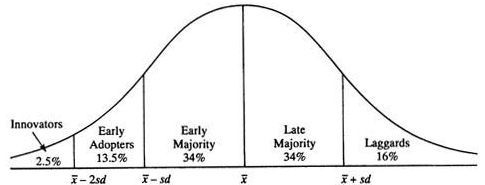
Generalizations
The book crystalizes some of the conclusions from the research into a set of generalizations. I’ve reproduced them here.
- 5-1: Earlier knowers of an innovation have more education than do later knowers.
- 5-2: Earlier knowers of an innovation have higher social status than do late knowers.
- 5-3: Earlier knowers of an innovation have more exposure to mass media channels of communication that do later knowers.
- 5-4: Earlier knowers of an innovation have more exposure to interpersonal channels than do later knowers.
- 5-5: Earlier knowers of an innovation have more contact with change agents than do later knowers.
- 5-6: Earlier knowers of an innovation have more social participation than do later knowers.
- 5-7: Earlier knowers of an innovation are more cosmopolite than are later knowers.
- 5-8: Re-invention occurs at the implementation stage for many innovations and for many adopters.
- 5-9: A higher degree of re-invention leads to a faster rate of adoption of an innovation.
- 5-10: A higher degree of re-invention leads to a higher degree of sustainability of an innovation.
- 5-11: Later adopters are more likely to discontinue innovations than are earlier adopters.
- 5-12: Stages exist in the innovation-decision process.
- 5-13: Mass media channels are relatively more important at the knowledge stage, and interpersonal channels are relatively more important at the persuasion stage in the innovation-decision process.
- 5-14: Cosmopolite channels are relatively more important at the knowledge stage, and localite channels are relatively more important at the persuasion stage in the innovation-decision process.
- 5-15: Mass media channels are relatively more important than interpersonal channels for earlier adopters than for later adopters.
- 5-16: Cosmopolite channels are relatively more important than localite channels for earlier adopters than for later adopters.
- 5-17: The rate of awareness-knowledge for an innovation is more rapid than its rate of adoption.
- 6-1: The relative advantage of an innovation, as perceived by members of a social system, is positively related to its rate of adoption.
- 6-2: The compatibility of an innovation, as perceived by members of a social system, is positively related to its rate of adoption.
- 6-3: The complexity of an innovation, as perceived by members of a social system, is negatively related to its rate of adoption.
- 6-4: The trialability of an innovation, as perceived by the members of a social system, is positively related to its rate of adoption.
- 6-5: The observability of an innovation, as perceived by members of a social system, is positively related to its rate of adoption.
- 7-1: Adopter distributions follow a bell-shaped curve over time and approach normality.
- 7-2: Earlier adopters are no different from later adopters in age.
- 7-3: Earlier adopters have more years of formal education than do later adopters.
- 7-4: Earlier adopters are more likely to be literate than are later adopters.
- 7-5: Earlier adopters have higher social status than do later adopters.
- 7-6: Earlier adopters have a greater degree of upward social mobility than do later adopters.
- 7-7: Earlier adopters have larger-sized units (farms, schools, companies, and so on) than do later adopters.
- 7-8: Earlier adopters have greater empathy than do later adopters.
- 7-9: Earlier adopters may be less dogmatic than are later adopters.
- 7-10: Earlier adopters have a greater ability to deal with abstractions than do later adopters.
- 7-11: Earlier adopters have greater rationality than do later adopters. Rationality is use of the most effective means to reach a given end.
- 7-12: Earlier adopters have more intelligence than do later adopters.
- 7-13: Earlier adopters have a more favorable attitude toward change than do later adopters.
- 7-14: Earlier adopters are better able to cope with uncertainty and risk than are later adopters.
- 7-15: Earlier adopters have a more favorable attitude toward science than do later adopters.
- 7-16: Earlier adopters are less fatalistic than are later adopters. Fatalism is the degree to which an individual perceives a lack of ability to control his or her future.
- 7-17: Earlier adopters have higher aspirations (for formal education, higher status, occupations, and so on) than do later adopters.
- 7-18: Earlier adopters have more social participation than do later adopters.
- 7-19: Earlier adopters are more highly interconnected through interpersonal networks in their social system than are later adopters. Connectedness is the degree to which an individual is linked to others.
- 7-20: Earlier adopters are more cosmopolite than are later adopters.
- 7-21: Earlier adopters have more contact with change agents than do later adopters.
- 7-22: Earlier adopters have greater exposure to mass media communication channels than do later adopters.
- 7-23: Earlier adopters have greater exposure to interpersonal communication channels than do later adopters.
- 7-24: Earlier adopters seek information about innovations more actively than do later adopters.
- 7-25: Earlier adopters have greater knowledge of innovations than do later adopters.
- 7-26: Earlier adopters have a higher degree of opinion leadership than do later adopters.
- 8-1: Interpersonal diffusion networks are mostly homophilous.
- 8-2: When interpersonal diffusion networks are heterophilous, followers seek opinion leaders of higher socioeconomic status, with more formal education, with a greater degree of mass media exposure, who are more cosmopolite, have greater contact with change agents, and are more innovative.
- 8-3: Opinion leaders have greater exposure to mass media than their followers.
- 8-4: Opinion leaders are more cosmopolite than their followers.
- 8-5: Opinion leaders have greater contact with change agents than their followers.
- 8-6: Opinion leaders have greater social participation than their followers.
- 8-7: Opinion leaders have higher socioeconomic status than their followers.
- 8-8: Opinion leaders are more innovative than their followers.
- 8-9: When a social system’s norms favor change, opinion leaders are more innovative, but when the system’s norms do not favor change, opinion leaders are not especially innovative.
- 8-10, which states: The network interconnectedness of an individual in a social system is positively related to the individual’s innovativeness.
- 8-11: The information-exchange potential of communication network links is negatively related to their degree of (1) communication proximity and (2) homophily.
- 8-12: Individuals tend to be linked to others who are close to them in physical distance and who are relatively homophilous in social characteristics.
- 8-13: An individual is more likely to adopt an innovation if more of the other individuals in his or her personal network have adopted previously
- 9-1: Change agents’ success in securing the adoption of innovations by clients is positively related to the extent of change agent effort in contacting clients.
- 9-2: Change agents’ success in securing the adoption of innovations by clients is positively related to a client orientation, rather than to a change agency orientation.
- 9-3: Change agents’ success in securing the adoption of innovations by clients is positively related to the degree to which a diffusion program is compatible with clients’ needs.
- 9-4: Change agents’ success in securing the adoption of innovations by clients is positively related to empathy with clients.
- 9-5: Contact with change agents is positively related to higher socioeconomic status among clients.
- 9-6: Contact with change agents is positively related to greater social participation by clients.
- 9-7: Contact with change agents is positively related to higher formal education among clients.
- 9-8: Contact with change agents is positively related to cosmopoliteness among clients.
- 9-9 states: Change agents’ success in securing the adoption of innovations by clients is positively related to their homophily with clients.
- 9-10 states: Change agents’ success in securing the adoption of innovations by clients is positively related to credibility in the clients’ eyes.
- 9-11 is: Change agents’ success in securing the adoption of innovations by clients is positively related to the extent that he or she works through opinion leaders.
- 9-12: Change agents’ success in securing the adoption of innovations by clients is positively related to increasing clients’ ability to evaluate innovations.
- 10-1: Larger organizations are more innovative.
- 10-2: Each of the organizational structure variables may be related to innovation in one direction during the initiation phases of the innovation process, and in the opposite direction during the implementation phases.
- 10-3: The presence of an innovation champion contributes to the success of an innovation in an organization.
- 10-4: A performance gap can trigger the innovation process.
- 10-5: Both the innovation and the organization usually change in the innovation process in an organization.
- 11-1: The effects of an innovation usually cannot be managed so as to separate the desirable from the undesirable consequences.
- 11-2: The undesirable, indirect, and unanticipated consequences of an innovation usually go together, as do the desirable, direct, and anticipated consequences.
- 11-3: Change agents more easily anticipate the form and function of an innovation for their clients than its meaning.
- 11-4: The consequences of the diffusion of innovations usually widen the socioeconomic gap between the earlier and later adopting categories in a system.
- 11-5: The consequences of the diffusion of innovation usually widen the socioeconomic gap between the audience segments previously high and low in socioeconomic status.
- 11-6: A system’s social structure partly determines the equality versus inequality of an innovation’s consequences.
- 11-7: When special efforts are made by a diffusion agency, it is possible to narrow, or at least not to widen, socioeconomic gaps in a social system.
Whew! This is definitely the longest book review I’ve written yet. If you’re serious about driving adoption in your organization or for your clients, pickup Diffusion of Innovations and see everything that I left out!
